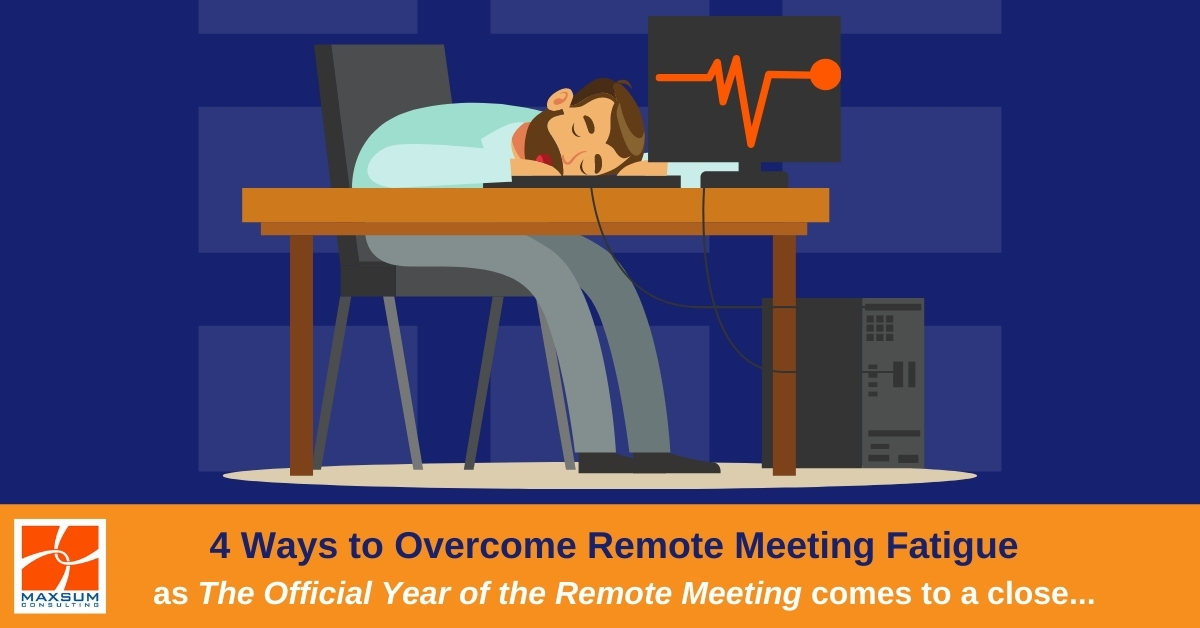[vc_row][vc_column][vc_column_text]
2020 – The Official Year of the Remote Meeting has made us tired and cranky!
Has nearly 10 months of back-to-back remote meetings left you tired, cranky, less patient, and dare we say it… less productive? Here’s why, PLUS a few tips to change things up ahead of 2021.
Ok we’re going to make a big call here.
Never before in the recent history of business and technology has anything come along that has so immediately, urgently and pervasively forced such a dramatic shift in the way people must work and interact with the outside world as the pandemic-fueled move to remote work and virtual meetings.
In our minds, we knew it was definitely doable. We were already used to more screen time on our always-on smart phones. Many of us were working in organisations that had already moved to flexible, collaboration-based communication tools like Microsoft Teams, regular remote interactions or flexible working arrangements were already forming a part of the work day , and we’d all been on a webinar or two before, right?
What we didn’t bank on up-front (not that we had time to think about it anyway!) was that our brains were not so ready. How? Because the human brain has evolved over millennia of primarily in-person interactions to register visual stimuli in our environmental surroundings, note our physical proximity to the person we’re interacting with, and subconsciously read body language and facial expressions to derive meaning and context and then guide us to respond and behave appropriately.
And whilst our minds may have readily pivoted on the fly to embrace video meetings to stay connected, it would seem that non-stop virtual meetings have left our poor old brains behind, scrambling for context in the dust!
The COVID Remote Meeting Surge – The pressure builds…
No matter what business you were in during COVID outbreak, Lockdown 1.0 and 2.0, things either got busy, difficult or isolating – sometimes all three! And you needed to talk to staff, customers, advisors, and agencies about it – remotely and often! Luckily we had the technology tools to make this work. Personal and professional video conferencing tools alike quickly rose to the challenge and we dived right in.
Microsoft’s study into the changing in remote working trends over the period from March 12 2020 to March 31, 2020 alone clocked the number of minutes spent in Microsoft Teams meetings per day ballooning from just under 560 million minutes per day to a whopping 2.7 Billion minutes per day!
And amidst this connect and communicate frenzy, it seems this is what we started doing:
- Squeezing early meetings or family and friend facetimes into what would have been our commute times
- Booking meetings back to back to back all day long – simply because we could, right?
- Working longer hours because, again, we were already home in time for dinner anyway and we hadn’t actually gotten any REAL work done all day because we were on so many calls!
In fact, the same Microsoft study has reported that the number of Teams chat messages exchanged between 8-9 a.m. and 6-8 p.m. (i.e. outside of the typical workday) increased between 15% and 23% and activity over weekends increased by over 200%.
The COVID Remote Meeting Plateau – Things start to get challenging…
On top of our already elevated pandemic-induced stress levels and increased working hours, the onslaught of digital input via video meetings has presented our brains with a barrage of unfamiliar challenges:
- We have to focus continuously on the screen to keep track of what’s going on.
- There are fewer non-verbal cues available for our brain to interpret.
- We can’t “read the room” and get a sense who wants to talk next or who’s turn it is.
- When your presenting or screen sharing, you can’t see or scan people for their reactions or emotions.
These factors are what experts now believe are leading to remote meeting fatigue.
The COVID Remote Meeting Fallout – Remote Meeting Fatigue sets in
- Brainwave markers associated with overwork and stress are significantly higher in video meetings that non-meeting related remote work.
- Due to the hard work our brains are doing to interpret new digital inputs, fatigue starts to set in 30-40 minutes into a meeting.
- On a day filled with back-to-back remote meetings, stress on the brain and the body sets in about 2 hours into the day.
Where to from here? How to approach remote meetings differently and prevent remote meeting fatigue…
If 2020 has taught us anything it’s that what’s around the corner for 2021 is anybody’s guess, and that we cannot underestimate the importance of protecting our health and wellbeing. As Australia starts to open up again, we see countries around the world head back into lockdown, evidence that collectively we have a way to go yet.
One thing that is a sure bet, however, is that remote meetings and interactions, especially for work-related purposes are going to be with us for a long time yet, and perhaps even here to stay…
What we need to do now is to use the tools available to us to manage our remote meetings and the time we spend in them in healthier and more productive ways.
1. Get control over your calendar again!
If you’ve had weeks and weeks of back-to-back remote meetings booked in your calendar, it’s time to take a new approach.
- Book in some permanent, scheduled, regular break times every 2 hours.
- Book in some regular Focus time that no meetings can be scheduled in over the top of.
2. Cut down on the chit chat!
We’ve been tempted just to use those one-hour blocks in the calendar, because we know that by the time everyone finds the links, gets online, and does the meet-and-greet, there’s not a lot of time left.
Moving forward though, try to:
- Schedule meetings in 30-minute instead of 60-minute blocks.
- Feel bad about cutting down the meet-and-greet time? Customise your meeting invites by adding a standard note explaining why you’re booking a 30-min session – your invitees will be onboard, trust us!
- Set the expectation that there will be a short break time during longer meetings.
3. Carve out/Claw back some quiet time
When you are not in meetings, make that time count!
If you need blocks of time to get some actual work done,
- Manage your notifications settings so you’re not getting pinged for everything across every device you use.
- Use custom status messages so people understand that you’re not MIA.
- Set up quiet hours or days on your devices to protect your down time.
And as for lunch…
- Make sure you’ve actually made time to get up and away from your device (that’s right team, no more turning your video and mic off while you chow down during a meeting!)
4. Use in-meeting tools and features to give your brain a helping hand
- Turn on new or updated meeting experiences, and use together or theatre mode functions to get a clearer view of people’s reactions or engagement.
- Change the size of gallery views and/or pin the video feeds of key panelists or presenters if you need to focus on just a few presenters in the session.
- Turn off focus mode during presentations so that you can see other people’s video feeds in the meeting if you need to “read the room”.
- Turn on focus mode if you want less distraction and need to focus on the presentation content instead.
- Record important or longer meetings, especially if you’ve had a long day already, so you can review them or come back to them later.
Find out now how to become a Microsoft Teams power user to manage your in-meeting time, your focus time, and your downtime better! Contact us for how to’s on 1300 629 786 (MAXSUM) or send a message to our demo team right here.
[/vc_column_text][vc_empty_space][vc_raw_html]JTNDZGl2JTIwY2xhc3MlM0QlMjJ3aXN0aWFfcmVzcG9uc2l2ZV9wYWRkaW5nJTIyJTIwc3R5bGUlM0QlMjJwYWRkaW5nJTNBNTYuMjUlMjUlMjAwJTIwMCUyMDAlM0Jwb3NpdGlvbiUzQXJlbGF0aXZlJTNCJTIyJTNFJTNDZGl2JTIwY2xhc3MlM0QlMjJ3aXN0aWFfcmVzcG9uc2l2ZV93cmFwcGVyJTIyJTIwc3R5bGUlM0QlMjJoZWlnaHQlM0ExMDAlMjUlM0JsZWZ0JTNBMCUzQnBvc2l0aW9uJTNBYWJzb2x1dGUlM0J0b3AlM0EwJTNCd2lkdGglM0ExMDAlMjUlM0IlMjIlM0UlM0NpZnJhbWUlMjBzcmMlM0QlMjJodHRwcyUzQSUyRiUyRmZhc3Qud2lzdGlhLm5ldCUyRmVtYmVkJTJGaWZyYW1lJTJGbnRwMjZqMHA0OSUzRnZpZGVvRm9hbSUzRHRydWUlMjIlMjB0aXRsZSUzRCUyMlRoZSUyMHdheSUyMHdlJTIwd29yay4uLiUyOEluc2lnaHRzJTIwZnJvbSUyME1TSW5zcGlyZTIwMjAlMjklMjBWaWRlbyUyMiUyMGFsbG93JTNEJTIyYXV0b3BsYXklM0IlMjBmdWxsc2NyZWVuJTIyJTIwYWxsb3d0cmFuc3BhcmVuY3klM0QlMjJ0cnVlJTIyJTIwZnJhbWVib3JkZXIlM0QlMjIwJTIyJTIwc2Nyb2xsaW5nJTNEJTIybm8lMjIlMjBjbGFzcyUzRCUyMndpc3RpYV9lbWJlZCUyMiUyMG5hbWUlM0QlMjJ3aXN0aWFfZW1iZWQlMjIlMjBhbGxvd2Z1bGxzY3JlZW4lMjBtc2FsbG93ZnVsbHNjcmVlbiUyMHdpZHRoJTNEJTIyMTAwJTI1JTIyJTIwaGVpZ2h0JTNEJTIyMTAwJTI1JTIyJTNFJTNDJTJGaWZyYW1lJTNFJTNDJTJGZGl2JTNFJTNDJTJGZGl2JTNFJTBBJTNDc2NyaXB0JTIwc3JjJTNEJTIyaHR0cHMlM0ElMkYlMkZmYXN0Lndpc3RpYS5uZXQlMkZhc3NldHMlMkZleHRlcm5hbCUyRkUtdjEuanMlMjIlMjBhc3luYyUzRSUzQyUyRnNjcmlwdCUzRQ==[/vc_raw_html][vc_empty_space][/vc_column][/vc_row]


